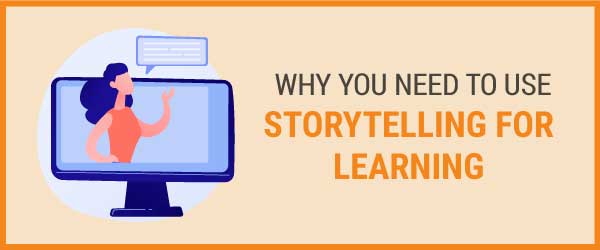
I’m sure you’ve heard by now that storytelling can make learning more effective. What is the importance of learning through stories? Stories help us process and remember information. Perhaps they even touch a part of our consciousness associated with the magic and creativity of childhood.
In my desire to become a better storyteller, I attended a session on the subject at a conference for presenters. Here are the key points I gathered from a session titled, The Art of Storytelling, presented by Jon Thomas. I modified them for learning experience designers as needed. In addition, to learn how to write better stories, listen to How to Make Stories Compelling or download the transcript.
1. Stories are the emotional glue that connects the audience to the message
Much of what people remember from a learning experience are the feelings of the underlying message rather than a multitude of small facts. Stories are an important way to tap into the heart of the audience, providing a channel for conveying a deeper message based on emotion. See What Makes Storytelling So Effective for Learning?
2. Construct information presentations around a story
Any kind of presentation—whether it be online training or a live presentation—will benefit from a story construction. Organizing information into a format with a beginning (setting the stage), middle (the challenge) and ending (new reality) can work for many topics. In many situations, learning through stories can be more effective than direct instruction.
3. People want to know about origins
When we watch or read about a superhero, we always remember the person’s origins. We know where they came from and the circumstances that created their super powers. People identify with their origins and are curious about where others (including fictional characters) come from, how they change and how they evolve. Include this type of information in your next story.
4. Stories reshape knowledge into something meaningful
For centuries, people have used stories to pass on knowledge. When you include information in the context of a story, you transfer it to a listener or reader in a unique way.
5. Stories make people care
When you know your audience—their pains, frustrations and joys—your stories can reflect their emotions and experiences. As learners begin to see themselves in the story and begin to identify with it, they start to care. Nancy Duarte, author of Resonate, states that a story serves as a moment of emotional appeal.
6. Stories transcend one’s current environment
Good storytelling can transport learners out of their stuffy meeting rooms and offices into an adventurous world away from the workplace. In this altered reality, the mind becomes more open to perceiving and thinking in new ways. This is an ideal position from which to learn.
7. Stories are motivating
Stories can motivate an audience toward a learning goal. They are ideal for attitudinal training because when an audience is motivated, they no longer need to be persuaded. An encouraging story will inspire someone to take action.
8. People take time for stories
Have you ever noticed that even the busiest of people will stop to listen to someone’s story or to tell one of their own? Novels, movies and gossip magazines attract millions of people because of their stories. If you want to maintain an audience’s attention, you’re more likely to do it through storytelling.
9. People are more likely to share stories
Stories are like magnets and people love to share them. They are the hooks that draw people in as the stories pass from one person to the next. If you have any doubts, check out the thousands of stories shared on social media sites? Do you need to spread the word about something? Put it in a story and see if it gets shared.
10. Stories give meaning to data
Many people perceive data as meaningless numbers. This happens when the data is disconnected to anything important in their experience. But when the data is placed in the context of a story, it comes alive. One of the most well-known examples of this is Hans Roling’s presentation The Best Stats You’ve Ever Seen.
Resources:
- See StoryTraining by Hadiya Nuriddin and Instructional Story Design by Rance Greene for more on storytelling for learning purposes
- If you will be shooting photographs to go along with your story, see How to Plan a Photo Shoot for eLearning.
- If you are using storytelling in a video, see Planning a Training Video Production.


thank you so much for the topic..now i know how to teach because i saw the important of story telling in the class… pleas give more information how to use it and time to use story to the learner.
from Tanzania am peter mwanga. mount meru university student.
Hi Yavuz,
You could try Storify.com or one of the animation programs (not free) like Powtoons or GoAnimate.
Connie
Hi ,
I’d like to create some business training using digital storytelling tolls but ? don’t have info about it. Could you offer a few software (for mac) to me about it ? I am using mac and prefer free ones 🙂
Connie,
This topic of weaving storytelling into learning is an area that fascinates me as an instructional designer. Your points about how stories can connect, motivate, inspire, give meaning and organize information in a connected way are truly insightful. After reading through your initial post I started researching others who are also tapping into this narrative type of education and are using it in their field. Here are some people I discovered to be inspiring when it comes to incorporating stories into learning and design.
Lisa Cron
In her book Wired For Story (http://wiredforstory.com/), she unpacks the power of story from a literary and neuroscience perspective. As an instructional designer I felt her insights into how the brain learns and structures information has an impact in how I begin to design and structure information in any E-learning course. What stood out to me directly was her simple definition of a story. A story is how what happens affects someone who is trying to achieve what turns out to be a difficult goal, and how he or she changes as a result. This is such a great definition where I could see a performance improvement training being re-shaped around this simple story definition in a way that engages the brain and learners.
Nancy Duarte
She is a master at telling stories and is passionate about how to incorporate the story structure into presentations. As you stated earlier, when a learner can see themselves in the story and begin to identify with it, then they can begin to care. Nancy is a master at this and gives a great TED explanation of why stories matter (http://www.ted.com/talks/nancy_duarte_the_secret_structure_of_great_talks).
As an instructional designer I look over her company’s work Duarte often to catch a glimpse of how they design and mobilize narratives to educate others through technology. (http://www.duarte.com/)
Dan Portnoy
In his work The Non-Profit Narrative (http://www.amazon.com/The-Non-Profit-Narrative-Telling-Stories/dp/0615599796) he states that every story needs a villain. In the non-profit sector that I serve this villain could be fighting against socioeconomic barriers or feeding the hungry. What I’m finding is that in the field of instructional design a villain could take the form of a performance gap within an organization. The design and instruction for solving this performance gap could revolve around the hero of the story defeating this “performance gap” villain.
Jeff Shinabarger
Jeff is a social entrepreneur that has a vision to make Atlanta a center for social innovation. His non-profit Plywood People (www.plywoodpeople.com) is helping people tell a better story with their lives through the problems they solve. The phrase he constantly uses is “we will be known by the problems we solve.” This same type of mantra could be said about instructional designers as they bridge gaps and develop new ways to see the world. I think stories are great vehicles to use when problems need to be solved within any organization and I think instructional designers can lead the way.
Cron, L. (2012). Wired for Story: A Writers Guide to using Brain Science to Hook Readers from the very First Sentence. New York, NY: Ten Speed Press.
Portnoy, D. (2014). The Non-Profit Narrative: How Telling Stories Can Change the World. Lexington, KY: Portnoy Media Group.
Plywood People: http://plywoodpeople.com/about/who-we-are/
Duarte: http://www.duarte.com/
Great Post ! You may visit “Learn Through Stories” http://www.learnthroughstories.com for more stories. Thanks ! 🙂
I agree totally. Even wrote an online tool for presenting stories for learning as eBooks and games.
http://stories4learning.com
Regards
Alan
Sweet insights. Thanks, David. Hope to hear from you again soon.
Connie
Connie, I still remember many of the lessons and the characters that told the stories, while I was sitting in my uncle’s town barbershop. Your points are spot on, stories bring data to life.
Lisa Cron, author of Wired for Story, writes “everything in a story gets it’s emotional weight and meaning based on how it effects the protagonist.” Stories help us all illustrate our own protagonist journey and effectively share our lessons with others through the power of story.
Hans Rosling’s viseo in brilliant because he connects the story of us, the wars and industrial revolution with his own story, born in 1948. These threshold moments anchor us in the meaning of the material and goes beyond the wonderful use of technology.
Great article.
Hi Helen,
First of all, storytelling is probably not the solution for every type of training. But it often is a good solution. In your case, two types of stories come to mind. One would be an overall story, for example, a complex job with a tough deadline is approaching and a new engineer needs to quickly get better at reading tech drawings. He or she must learn from some of the experienced people around the organization. This is your apprentice-master setup. You can allow the learner to select questions or to select answers and to get context-sensitive responses.
Another idea is to simply add small workplace scenarios that require reading tech drawings. Add a little tension, challenge or friction to each scenario. I hope this helps and I hope others chime in with ideas!
Best,
Connie
I’m developing engineering training – teaching how to read tech drawings, execute changes to drawings, designing screw threading for parts, corrosion prevention, etc. Please let me know how I might use stories in this type of training. thanks!
Hi
How can I do something like that? what software should I use? (as the guy from the BBC)
Nice story telling example
Regards
Laura
Great additions, Adam. Thanks!
Thanks for this. Lots of great points. I’d add a few others that come from the case-based reasoning literature:
1. Real expertise is built on the tacit knowledge that comes from experience. We know this instinctively – no one hires a doctor, a lawyer, or a CEO based on test scores or coursework. Stories are the best way of communicating the knowledge that is embedded in experience, short of actually giving learners the opportunity to practice themselves (which isn’t always possible).
2. Rules and principles tend to be brittle where stories can be applied to situations much more flexibly. A small mismatch between a rule and a situation often leads to the rule being dismissed as irrelevant. In contrast, with stories, people can usually adapt the lessons embedded in stories to a much broader set of analogous situations. Arguably, this is at the heart of cognition – I have an experience that is represented as a story in my memory, and it reminds me of relevant prior experiences (i.e., more stories) that I use to make sense of the new experience.
It was my pleasure to share this, Jon. This topic really resonates with readers of The eLearning Coach as we become more aware of the value of stories for improving motivation, comprehension, retention and recall.
Best,
Connie
Connie,
Thanks so much for attending my session and for writing this post! I’m glad you found it useful and spread it to your engaged audience. Stories are part of our DNA. We’ve been telling them for centuries upon centuries. There’s no reason that they’ll stop being effective today! While stories have a basic structure, they do come in many different shapes and sizes. It’s simply about finding the story that will resonate with your audience.
Thanks again!
Jon
HI Jordan,
It’s great to hear from personal experience that stories work for you. Thanks for chiming in here.
Connie
Hi Bryce,
I agree. The motion graphics really make data compelling.
Connie
I like the way you stated that, Howard. Thanks. 🙂
Good points; Stories – at least from a psychological perspective – are the killer app for today.
I agree, Effective storytelling is an integral part of the teaching process. Stories capture the emotional interest of the listener in a way that normal lectures would never have touched on.
That video is also a great example of “Motion Graphics,” taking a complex set of data and presenting it in either a static visual form (infographics) or a short video (motion graphics).